 NOTE: My original blog was shut down without warning by WordPress. It has not been possible to recover all of it which is why many of the original graphics in this article are missing.
NOTE: My original blog was shut down without warning by WordPress. It has not been possible to recover all of it which is why many of the original graphics in this article are missing.
On 12/2/19, Haringey ReSisters organised a meeting in North London, for those concerned or curious about the teaching of gender identity in schools and the social and medical transition of children. Stephanie Davies-Arai of Transgender Trend was a speaker, and with Claire Graham indisposed, Dr Heather Brunskell-Evans and Dr Julia Long stepped in at the last moment. Venice Allan was Chair.
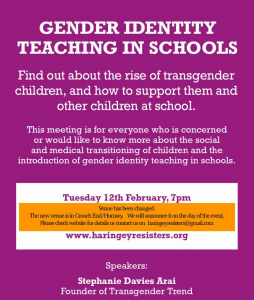
I met up with Charlene and Anna at Victoria Station Starbucks, with just enough time to down a coffee before hopping onto a tube to Finsbury Park. A quick bus ride from there took us to the venue. I’d worried that we were running late, but we arrived about 20 minutes before the meeting was due to start.
Arriving on a quiet, leafy and dimly-lit residential street, I thought we might have taken a wrong turning. Then I saw a church spire rising up above the trees. Intricate stained-glass windows splashed colour back onto the dark street. We passed through an iron gate and under a white stone arch, where we were welcomed to the meeting by women from Haringey ReSisters. Although not as august a venue as St Mary le Bow, where I had attended the Let a Woman Speak meeting back in November, the church was impressive. (Both Let A Woman Speak and Haringey ReSisters are secular organisations; the meetings just happened to be in churches, partly because of the difficulty of finding a venue that won’t be intimidated into cancellation.) The temperature was unsurprisingly much warmer inside the building. I took off my coat and put it over the back of a well-positioned chair, milling around and talking to a couple of women I had met elsewhere, before going outside again with Emma, who wanted a quick cigarette before the talks began.
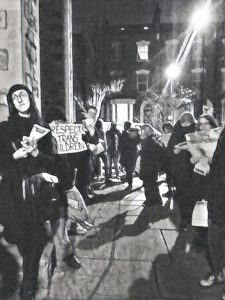 When we stepped outside I was surprised to see that in those 10 minutes a group of about 25 well-wrapped up protesters had arrived and established themselves on the path leading to the church.
When we stepped outside I was surprised to see that in those 10 minutes a group of about 25 well-wrapped up protesters had arrived and established themselves on the path leading to the church.
“Well, they sprang from nowhere,” I remarked to nobody in particular.
Some were holding a large sheet, painted on it the words: ‘believe trans kids‘. The slogan seemed non-specific and unclear. Believe what? That some children are confused and made miserable by society’s gender stereotypes, resulting in dysphoria and unhappiness? That these kids need love and support? Or that somehow, some children ‘know’ that they are born in the ‘wrong’ body and that attempts should be made to fix this with untruths, medications and surgery? Should we ‘believe trans kids’ if they tell us they need cake for dinner every night? To drink vodka, have sex or smoke crack?
I realised that what I’d presumed was a scarf hiding the face of one was actually a mask. Another seemed to be holding a megaphone but showed no signs of intending to use it. They seemed fairly calm & unintimidating. At a guess, they were mostly uni students. Later, as we were leaving, one told Emma that she’d be qualifying as a doctor next year (which I found most disconcerting considering her inability to understand basic biology).

Protestors outside the hall holding a banner reading ‘Believe Trans Kids’.
Some of the protestors clasped handfuls of leaflets. Although I lurked nearby, nobody offered me one.
“Go on, get one,” Emma prodded me, taking a drag on her cigarette. “Go and ask.”
“You get one.”
“No, you do it. Go on, get me one too!”
I sighed and approached a be-beanied young woman.
“May I have a leaflet, please?” I asked, politely. “Actually, may I have two?”
“They’re funded by the far right,” she told me earnestly, handing me a leaflet entitled ‘Who Are Transgender Trend? “Dangerous” and “misleading” conversion therapy advocates with links to the US Evangelical right!”
‘Conversion therapy advocate’ seems to me a strange accusation to be leveled at those who want to protect kids against transition- especially from those who would support attempts to convert girls into boys and vice versa. I walked back to Emma and offered the leaflet for her perusal.
“Ridiculous,” she proclaimed after a few minutes, extinguishing her cigarette. “Totally untrue and probably libelous too. ‘Links to the US Evangelical right’. As if. I mean, what the fuck are they thinking?”
The hall was filling up so we headed back inside to take our seats.
Below are pages 4,1,2,3 of the leaflet, which was folded in half.
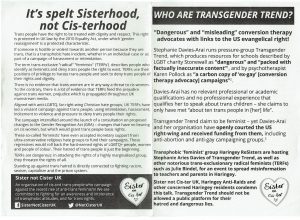
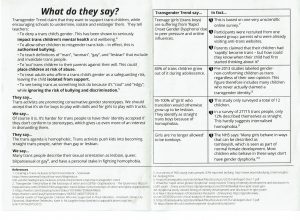
Below are both sides of the leaflet that TransgenderTrend made available at the meeting:
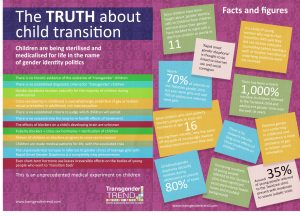
We took our seats as the speakers, Chair and organisers made a few last-minute adjustments, and the meeting was ready to begin.
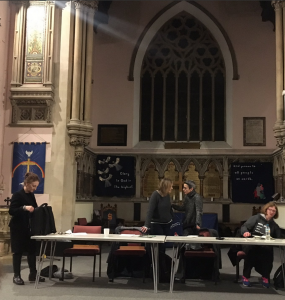
Dr Julia Long
 Julia Long was first to speak. She described herself as ‘the warm up’ for the speakers to follow and referred to the ‘desperate state of play’ currently facing young lesbians, advising us that her recent trip to the States had only served to further convince her of this.
Julia Long was first to speak. She described herself as ‘the warm up’ for the speakers to follow and referred to the ‘desperate state of play’ currently facing young lesbians, advising us that her recent trip to the States had only served to further convince her of this.
She talked of perusing a UN document concerning cultural genocide while in the USA and how it had struck her that this bore a striking similarity to the crisis currently facing the lesbian community. Admitting she had initially had concerns that people might think her comparison ‘a bit hyperbolic’ Long asserted that the destruction of lesbian language, heritage and resources is indeed very real and is made especially disturbing by the fact that some of the greatest cheerleaders of transgenderism are lesbians. She pointed out that as lesbians love other women, the definition of lesbian is entirely dependent on the definition of woman.
“I’m really hard pushed to think of the destruction of a group of people that has ever been so championed by those among that people itself.”
Long went through the definitions of actions that constitute cultural genocide in the eyes of the United Nations, starting with:
“Any action which has the aim or effect of depriving a group of their integrity as distinct people or their cultural values (and/or) of dispossessing groups of their lands, territories or resources.”
While recognising that it was written for a different context to the one in which she was using it, Julia pointed out that ‘the fertile soil in which lesbians can thrive… is lesbian-only space and women-only space,’ and how that is being sabotaged by those who support ‘the decimation of these spaces’.
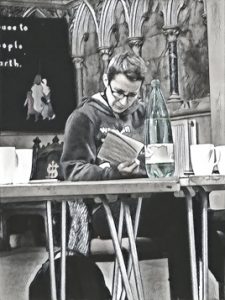
Dr Julia Long
She spoke of how funding no longer provides resources for distinctly lesbian groups; of the invasion of lesbian spaces by adult men claiming to be lesbians and of the ‘damaging and alienating process’ that is the destruction of the bodies of young lesbians ‘who believe it is so ugly, grim and socially ostracising’ to be a lesbian that they are being made into ‘pseudo-heterosexuals’ through the use of puberty blockers and cross-sex hormones. In America, double mastectomies are being performed on girls as young as thirteen. While in the USA, a nurse had told Posie Parker that the hospital she worked in was performing between four and six double mastectomies every day on the bodies of young women.
Some of these young women will go on to have mostly useless appendages resembling penises made from their own skin, harvested from their thighs or forearms.
Referring also to ‘forced assimilation or integration’ Long referenced the US Equality Act, which will outlaw those who might wish to ‘put the breaks’ on a young woman’s transition, and how any room for creating a space to question the narrative of transgenderism will be outlawed and called conversion therapy.
Finally she spoke of the ‘avalanche of propaganda’ directed against a victimised group in relation to cultural genocide: young women being told that being lesbian is transphobic and encouraged to read articles with titles such as ‘how to have lesbian sex with a transwoman’.
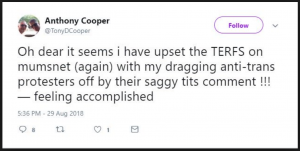 Dr Long reminded the audience of the misogyny rife in the LGBT movement, the ‘avalanche of propaganda’ against lesbians and how Anthony Cooper, a gay compere at Manchester Pride, had said the lesbians protestors, including herself, should have been ‘dragged away by their saggy tits’. She concluding by saying she hoped the audience would feel ‘galvinised to be more active’ in the fight against the erasure of young lesbians.
Dr Long reminded the audience of the misogyny rife in the LGBT movement, the ‘avalanche of propaganda’ against lesbians and how Anthony Cooper, a gay compere at Manchester Pride, had said the lesbians protestors, including herself, should have been ‘dragged away by their saggy tits’. She concluding by saying she hoped the audience would feel ‘galvinised to be more active’ in the fight against the erasure of young lesbians.
You can hear Dr Long’s talk here.
Stephanie Davies-Arai of TransgenderTrend
 Stephanie Davies-Arai is a mother, a communications skills trainer and an author. She has worked in schools and with teachers and with parents for almost twenty years. She founded Transgender Trend in 2015, in response to parents concerns about the issue of transitioning kids.
Stephanie Davies-Arai is a mother, a communications skills trainer and an author. She has worked in schools and with teachers and with parents for almost twenty years. She founded Transgender Trend in 2015, in response to parents concerns about the issue of transitioning kids.
“I see the devastating impact of gender identity ideology on parents and families just about every day.” Stephanie began. ” I hear from parents who are being told that their teenage daughters are now literally their sons because of their gender identity: who watch as the whole world tells their daughter she’s brave, while they are called transphobic bigots for not wanting their daughter to get her breasts cut off or take hormones that will have a serious and irreversible effect on her body; for not wanting her set up for a lifetime of health problems, a lifetime as a medical patient and probably a shortened lifespan: for wanting to know where the evidence is for a treatment so drastic that it may leave her infertile with uterine and vaginal atrophy leading to hysterectomy further down the line. The possibility of excruciating pain during orgasm, surgical complications if she decides on a phalloplasty, leading to incontinence in around 50% of cases. And that’s quite apart from the increased risk of various cancers.”
Davies-Arai spoke of parents’ concerns that their Barbie-loving boys and short-haired girls were being marked out as potentially transgender, often by those close to the child, and that children are calling their own sex into question after transgender presentations in their primary schools. She also hears frequently from young women who regret transition and feel angry that no adult, teacher or professional, ever told them they couldn’t actually change sex: angry that “that they’ve been set up to believe a myth.”
‘Persistent, consistent and insistent’ is the mantra that is said to prove a child is ‘really’ transgender. Davies-Arai was all three in her assertation that she was a boy: throughout her childhood and into adulthood. Self harm, anorexia, bulimia and depression were all results of her dysphoria. Yet now, she told the audience, she is the mother of four children.
“I shudder to think that I was growing up today, not only would I be diagnosed with gender dysphoria but I would be judged an extreme case. I would have jumped at the chance to take puberty blockers to stop me developing into something I believed I was not.”
She is, she says, far from alone in this experience. “Identity is not reality” and we should not be teaching children that their bodies are ‘some kind of inconvenient mistake’. Our true selves are not split off from our bodies. This disassociation would normally be recognised as harmful to a child’s wellbeing, but suddenly we have changed from seeing ‘a child who presents with gender dysphoria’ to seeing a ‘transgender child’. This difference in perception is vast.
“In this move we politicise both the child and a childhood clinical condition. A child with gender dysphoria may be helped and supported, the transgender child becomes an emblem for a social justice and political rights movement. Children affected by gender dysphoria should not be used to further any political agenda, or provide proof of any ideology.”
Stephanie expressed concern that those who are providing guidance and professional training for the NHS and for teachers are not themselves professionals but “highly funded lobby groups with very specific and extreme political goals”. Gendered Intelligence, Mermaids, GIRES, Allsorts and others expect teachers to learn new words and new ideological concepts and definitions. ‘Boy, girl, man and woman’ are words that are left undefined.
The schools’ guidance offered by such organisations is “all about the blurring of sexual boundaries under the guise of diversity and inclusion”. Toilets, changing rooms and overnight accommodation become mixed sex and erode children’s privacy and boundaries.

“The establishment of mixed sex facilities is one of the key campaign goals of the transgender movement, which essentially wants to replace sex with gender identity as the defining characteristic and distinction between men and women in culture and in law.”
Davies-Arai is concerned that affirmation has become the only approach offered for children with gender disphoria. Adamant that a child with gender dysphoria needs to be accepted and supported in school she stresses the importance of ‘robust anti-bullying policies’. Davies-Arai believes that affirmation is unlikely to be the best thing for a gender dysphoric child. She reminded us that in 80% of cases in pre-pubertal children gender dysphoria is most likely to resolve itself and these children frequently grow up to be gay. Children too young to have a sexual identity are being taught about gender identity, and support for confused children has been remarketed as ‘conversion therapy’.
“The very purpose of affirmation,” says Davies-Arai, “Is to keep a child in a state of gender dysphoria.” When trusted adults repeatedly reaffirm the dysphoria, it becomes less likely that it will resolve. In addition, social transition has been found to be a predictor of persistence of gender dysphoria.
“This should be obvious.” asserts Davies-Arai. “Children are suggestible. They believe adults and particularly adults in positions of authority such as teachers.”
She pointed out that teachers may be unaware that there is no concensus among professionals on how to treat children with dysphoria, and that more and more doctors are expressing concerns about unquestioning affirmation, which is far from the ‘neutral act of kindness and acceptance’ which it purports to be, but rather an act of reinforcement which ‘actively influences the child towards that prescribed outcome’.
Despite lobby groups claims that the effects of puberty blockers are fully reversible, there are no long term studies to back up this claim. The drugs used to treat children with gender dysphoria have not been tested for this purpose. Studies are only now being done on sheep, and the resulting negative effects on cognitive function do not stop when the medication stops.
“Blockers were tested on children before they were tested on animals.” observed Stephanie, speaking of the “casual normalisation of hormone treatments which are referenced (by lobby groups) as lightly as changing clothes or changing pronouns.”
Vulnerable children are being put at risk. Many have mental health problems, or are suffering from past trauma. Many others are autistic or gay and most are girls. Schools are not always aware of these factors, or of the possibility of social contagion via social media. “It is crucial that schools offer proper support to the most vulnerable young people and all underlying factors must be considered as part of a school’s safeguarding duties towards each individual child.”
Davies-Arai pointed out that ROGD (rapid onset gender dysphoria) is a completely new presentation and that there is no clinical model of care for this group. Self harm and depression in teenage girls are on the rise, but- for example in the recent Stonewall study- these girls become lost in the ‘unsexed’ transgender category. Our understanding, she says, moves from ‘‘teenage girls are in crisis and we need to understand why’ to ‘transkids are at high risk of suicide’.’ Other factors are not considered and the skewed suicide statistic is used by lobby groups to scare parents and emotionally blackmail them into supporting transition.
A new Memorandum of Understanding on conversion therapy produced a few years ago now includes gender identity for the first time. Therapists and counsellors are prevented from helping a child explore the underlying issues and this leaves therapists only able to affirm a child’s ‘gender identity’ or be accused of conversion therapy.
“Adolescents who identify as transgender are effectively placed outside safeguarding in schools… nowhere else does… a doctor agree with the patient’s self diagnosis and prescribes the treatment that the patient demands.”
The Education Act 1996 states that children are supposed to be protected against political indoctrination in schools and Davies-Arai believes that schools using the materials produced by transgender lobby groups without other balancing materials are in breach of this policy, and that the model of unquestioning affirmation is in breach of both the 1989 Children Act and UN law.
“I wrote this alternative guide for schools because of my concerns that… schools are being used as an arena for a political campaign. I think that is wrong: I don’t think it serves the best interests of children,” concluded Stephanie. “If you would like a copy, please see me afterwards, or you can order them.”
You can hear Stephanie Davies-Arai’s full talk here.
Note: Transgender Trend have “developed a comprehensive guidance for schools, in consultation with teachers, child protection and welfare professionals and lawyers. Their aim is to arm schools with all the relevant facts so that teachers feel more informed and confident in creating a safe school for all pupils, including non-conforming children and those who identify as ‘transgender’.”
The Transgender Trends schools guide can be downloaded here.
As Stephanie finished her talk, Venice interjected that those who were live tweeting might want to use the hashtag #haringeyresisters.
Allan then announced the last speaker, Heather Brunskell-Evans, co-author and editor of the book ‘Transgender Children & Young People – Born in Your Own Body‘ which is available from Cambridge Scholars here and from Amazon here.
Dr Heather Brunskell-Evans

Dr Brunskell-Evans observed that she had only been asked to step in four hours earlier, so would put any ‘imperfections’ in her talk down to lack of time to prepare. She added that she did not intend to cover the material that had already be discussed by Davies-Arai, and thanked Stephanie for the research she has done, describing her work as “completely measured, rational, thoughtful and evidence-based.”
Heather reflected on how such work can be treated as “so outrageous that it can be thought of as hateful and phobic” commenting that “what’s controversial to me is that we’re experimenting on our children at the moment” and asking “how have we got here?”
She started by referencing the young people we passed on the way into the meeting and saying that she did not judge them. “They imagine they’re being revolutionary and progressive.” They believe that they have the answers to gender, holding a fundamental belief that gender identity is inherent, although they are unable to explain where exactly it is. She reflected that she could sympathise with this belief because of the context in which they’d been educated, observing that they wouldn’t come in and listen to the talks and wondering, “how have we come to a world where people won’t even hear ideas to decide if they disagree with them or not?”
The idea of an inherent gender identity proposes that transgender children are ‘real’. Brunskell-Evans puts her head above the parapet by proposing that they are not real; that the idea of the transgender child has been fabricated. To be transgender you would have to not only be born in the wrong body but to have a gender identity ‘born with you’ that doesn’t match.
Brunskell-Evans reflects that gender used to be seen by progressive people as something that was socially constructed. She and her husband had no problem with her ‘very pretty’ young son growing his hair long and wearing dresses. She said they didn’t assume her son would be gay – just that he wanted to know what it might be like to be a girl in the same way he might want to know what it would be like to be a fire engine driver.
“We prided ourselves on the fact that we had a son who felt cool enough and relaxed enough that he wanted to experiment – because children experiment with different roles. That’s what children do, and we used to support children at these different stages.”
The idea of the transgender child has ‘grown and taken root’. Those who say there’s no such thing as a transgender child are now looked on with suspicion by those who assume their position means they are ‘against transgender rights and unsympathetic towards gender-confused children’. People become scared of saying ‘I don’t quite believe that’ because belief in the transgender child enters the realms of an almost religious faith. There are children in this country who have been taken into care because their parents didn’t believe they were transgender. Now schools, hospitals, police and social workers all purport to believe there is such a thing as a transgender child. Teachers assume that organisations like Gendered Intelligence and Stonewall must be correct in their opinion, otherwise why would they be the ‘go to’ people? Although these are self-appointed experts, to question them is currently seen as tantamount to heresy.
“Teachers seem to believe in it, parents seem to believe in it and then they take (the children) to gender identity clinics and doctors seems to believe in it… this all helps to construct the child… this child has been in the making in a very brief period of time: it doesn’t actually exist, the Transgender Child. A child who is confused about gender no doubt has existed for as long as gender as a social construct has existed, because gender is confusing… are you masculine enough? Are you feminine enough?…”

Heather and Stephanie
Heather does not claim that gender confusion doesn’t exist, but wants to reverse the trans doctrine that “trans children have existed for ever and we’re progressive now because we can recognise their existence and they can come out of the woodwork”. She believes that we do our children a great disservice when we think like that.
“Let’s be truly progressive and let children be whoever and whatever they are and not confine them to this reactionary idea that there is a deep and inherent masculinity or femininity. We’re going back years and years and years by adopting that.”
She concluded by saying that tracing the history of this concept had been fascinating, watching it take hold on society until we have reached the point where it is accepted, adding that shockingly some of the medical practitioners advocating for and prescribing blockers and hormones have anonymously confided that they themselves don’t believe in the idea of the transgender child.
“One day this whole debacle, this terrible thing that has happened in history to our children, will be exposed and that one day we’ll look back at this period of time… and think ‘how did people go along with that? How could that have been done in in broad daylight?’ What was it that was going on that made people petrified – even doctors – to stand up and say ‘the emperor has no clothes on’?
After Brunskell-Evans had finished her talk, there was an hour of open questions from the floor.
“What can we do?” asked one person, and the concensus was: send your local school a Transgender Trend pack; write to your local council and your MP, who need to realise that trans advocacy groups are political campaign groups, not child support groups. Copy in the Women’s Equality Commitee. Lobby politicians. Tell any parents you know. Speak to friends. Be brave. Be active in educating people about their right to ask these questions.
Support organisations like Transgender Trend – financially, if possible. You can do that here. Their schools packs have been sent out all over the UK and they are really making a difference.
“The overwhelming response we’ve had from teachers is relief.” said Stephanie, adding that it was important for TGT to receive a response from the schools who have received a pack. Feedback is vital and encouraging. One parent had told her, “I got my local council to unblock your website!”
The National Education Union supports the Allsorts pack. Speaking of the Allsorts pack, Davies-Arai said, “It’s under the guise of diversity and inclusion. Girls have a right not to be inclusive. This is really important. Girls – both sexes – have a right not to include the opposite sex in their private spaces…. but girls in particular, of course, because it is an issue of safety- and this does not mean that trans kids are predators. It means that a boy who identifies as a girl is still male.”
Someone said they worked for a council which was headed by the ‘proud mum of a trans child’ and that they felt ‘terrified to talk about this (transgenderism) in the council’.
Julia Long said that she no longer felt in the mood to write letters, that it was necessary to think outside social structures. “Schools produce norms of gender,” she said. “Schools produce compliant, heterosexual woman.” Gender is a politcial construct which is about normalising male domination of women. She also criticised the term ‘gender critical’: “The term ‘gender critical’ emphasises the level of timidity with which this debate is still being conducted and I’d like to see us all being a little less timid about it.”
There was a brief discussion on what happens when ‘the other side’ takes control of language; the rebranding of male violence against women as ‘gender-based violence’ and how creating the concept of ‘trans’ had helped to veil the males at the centre of the problem. It was also noted, with some disappointment, that Women’s History Month had now been lumped in with Gender Equality Month.
A spokeswoman for Haringey Resisiters asked local people to keep them posted about what is going on in Haringey schools and also to ask Haringey council to disassociate with Stonewall, who were referred to as ‘a misogynistic and a sexist organisation’. A campaign was suggested to get Stonewall and GIRES out of the schools.
“It sounds extreme to say this is a fascisitic movement,” said Heather, “but I know- I actually know – that it is. Because I know that people are being prevented – actively being prevented- from speaking out… every country that has become fascistic starts at a low level with people not speaking out, being frightened to speak out… this is happening in our country, which is supposed to be a liberal democracy.”
“We’ve talked about schools, do you have anything to say about universities?” asked a woman at the back.
Heather said that until six months ago she’d taught in universities all her life and believed that most “students have a firm belief that gender identity is a thing and anyone who resists or critiques that is utterly hateful.”
It’s hard to change the tide when there’s no funding for any research or for projects looking into transgenderism, although you can get thousands of pounds from the Economic and Social research Council to look at pregnant men.
Someone said that the LGBT stand in Fresher’s week at one university had been unable to offer a lesbian student any leaflets or literature on lesbianism from their plethora of pamphlets and books. They had offered her a leaflet about bisexual women instead, and told her she could look in the library for books by lesbians.
Dr Long observed that she had little faith in academics at present because they have proved themselves to be “supremely stupid” in the way they are dealing with this issue in universities. She mentioned some young lesbians who were prevented from having their own lesbian group at their university – the group had to include the words ‘self-defining’. It wasn’t just young lesbians being targeted, she said, but older women too.
“I feel like this is really an active erasure of lesbians,” put in Stephanie. She spoke of the business model employed at a Tavistock conference she attended, where speakers talked about initiatives to expand their client base – this included setting up a group for 5-11 year olds. Stephanie had asked how lesbians could be protected and after an initial ‘perplexed silence‘ was told that the speaker’s organisation had a thriving lesbian presence in their 18-25 year old group. She then realised they were talking about ‘lesbians with penises’. When Stephanie pointed out that she was talking about female lesbians the speaker, Jay Stewart, told her “that’s so 20th century.”
“If you’re a lesbian, be visible,” added Julia, “be visible in the world with your lesbian friends as much as possible, because young lesbians need to see us. If you’re not a lesbian, support lesbian visibility, talk about lesbians, make sure that young women know that it’s great to be a lesbian.”
“That’s all the time we’ve got left for questions.” concluded Venice, drawing the meeting to a close. “Thanks to everyone who came. I’ve just been told that in the last few minutes Haringey Resisters have been shadow banned from Twitter, so it’s really important that we all tweet and quote tweet @haringeyReSist and this hashtag and all the things that have come up at this meeting… if you look at their website you can find out how to get in touch.”

As I left the meeting I saw Venice talking to some of the transactivists outside and filming the exchanges on her phone. There seemed to be a few more than there had been at the start.
You can view the exchange here.
I have to say, if this is the face of modern activism, it’s pretty damn depressing. There is some talk of biscuits and a guy insists Juile Bindell is there (she wasn’t) Then they all set up that ridiculous chant of ‘believe trans kids’.
“Can you explain what you mean by ‘believe trans kids?'” asks Venice, to which the protestors respond, “You’re a cunt.” “You’re a fascist.”
 One of the protestors waved a piece of card at me. It read, “How was your trip to the Heritage Foundation, Julia. Did you enjoy hanging out with your right-wing anti gay anti abortion friends?”
One of the protestors waved a piece of card at me. It read, “How was your trip to the Heritage Foundation, Julia. Did you enjoy hanging out with your right-wing anti gay anti abortion friends?”
“I’ll pass on the message,” I said. “Although you could have come to the meeting and asked her yourself.”
“We weren’t allowed in!” protested a young woman.
I asked one of the organisers about that in the pub later, and was told it had been a public meeting and any individual could have come in. In fact, several protestors did come in to use the toilet, and at least one did stay for the meeting. The only time they were refused admission was when a couple of them asked if they could all come in, after the meeting had already started. It seemed to me to be fair enough that they were refused admission at that point, especially in the light of what happened when a group of transactivists blocked the way of women at a meeting in Bristol. When they were told no, they accepted it. There were no scuffles or threats, although I found it disappointing that as usual the pre- and post-meeting debate went no further than a few random chants and accusations of fascism.
As I left, the activists had begun a different chant, as vacuous and vague as the first. ‘Respect trans kids! Respect trans kids!’ I headed to the pub with Heather. I was looking forwards to a nice cool drink and a bag of crisps.

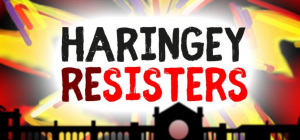
Pingback: Haringey ReSisters Report By Lily Maynard | Madam Nomad
reblogged on Madam Nomad. Very professional writing!
Pingback: YES, BUT WHAT DO THEY ACTUALLY WANT ??? -Lily Maynard